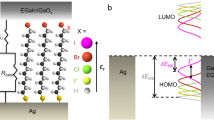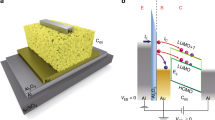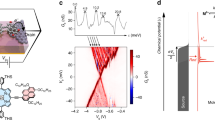Abstract
Solid-state molecular tunnel junctions are often assumed to operate in the Landauer regime, which describes essentially activationless coherent tunnelling processes. In solution, on the other hand, charge transfer is described by Marcus theory, which accounts for thermally activated processes. In practice, however, thermally activated transport phenomena are frequently observed also in solid-state molecular junctions but remain poorly understood. Here, we show experimentally the transition from the Marcus to the inverted Marcus region in a solid-state molecular tunnel junction by means of intra-molecular orbital gating that can be tuned via the chemical structure of the molecule and applied bias. In the inverted Marcus region, charge transport is incoherent, yet virtually independent of temperature. Our experimental results fit well to a theoretical model that combines Landauer and Marcus theories and may have implications for the interpretation of temperature-dependent charge transport measurements in molecular junctions.
This is a preview of subscription content, access via your institution
Access options
Access Nature and 54 other Nature Portfolio journals
Get Nature+, our best-value online-access subscription
$29.99 / 30 days
cancel any time
Subscribe to this journal
Receive 12 print issues and online access
$259.00 per year
only $21.58 per issue
Buy this article
- Purchase on Springer Link
- Instant access to full article PDF
Prices may be subject to local taxes which are calculated during checkout




Similar content being viewed by others
References
Yuan, L. et al. Controlling the direction of rectification in a molecular diode. Nat. Commun. 6, 6324 (2015).
Du, W. et al. On-chip molecular electronic plasmon sources based on self-assembled monolayer tunnel junctions. Nat. Photon. 10, 274–280 (2016).
Chikkaraddy, R. et al. Single-molecule strong coupling at room temperature in plasmonic nanocavities. Nature 535, 127–130 (2016).
Vilan, A., Aswal, D. & Cahen, D. Large-area, ensemble molecular electronics: Motivation and challenges. Chem. Rev. 117, 4248–4286 (2017).
Jeong, H., Kim, D., Xiang, D. & Lee, T. High-yield functional molecular electronic devices. ACS Nano 11, 6511–6548 (2017).
Shpaisman, H. et al. Structure Matters: Correlating temperature dependent electrical transport through alkyl monolayers with vibrational and photoelectron spectroscopies. Chem. Sci. 3, 851–862 (2012).
McCreery, R. L. & Bergren, A. J. Progress with molecular electronic junctions: Meeting experimental challenges in design and fabrication. Adv. Mater. 21, 4303–4322 (2009).
Landauer, R. Spatial variation of currents and fields due to localized scatterers in metallic conduction. IBM J. Res. Dev. 1, 223–231 (1957).
Joachim, C. & Ratner, M. A. Molecular electronics: Some views on transport junctions and beyond. Proc. Natl Acad. Sci. USA 102, 8801–8808 (2005).
Moth-Poulsen, K. & Bjørnholm, T. Molecular electronics with single molecules in solid-state devices. Nat. Nanotech. 4, 551–556 (2009).
Garrigues, A. R. et al. A single-level tunnel model to account for electrical transport through single molecule- and self-assembled monolayer-based junctions. Sci. Rep. 6, 26517 (2016).
Migliore, A., Schiff, P. & Nitzan, A. On the relationship between molecular state and single electron pictures in simple electrochemical junctions. Phys. Chem. Chem. Phys. 14, 13746–13753 (2012).
Hines, T. et al. Transition from tunneling to hopping in single molecular junctions by measuring length and temperature dependence. J. Am. Chem. Soc. 132, 11658–11664 (2010).
Ho Choi, S., Kim, B. & Frisbie, C. D. Electrical resistance of long conjugated molecular wires. Science 320, 1482–1486 (2008).
Sayed, S. Y., Fereiro, J. A., Yan, H., McCreery, R. L. & Bergren, A. J. Charge transport in molecular electronic junctions: Compression of the molecular tunnel barrier in the strong coupling regime. Proc. Natl Acad. Sci. USA 109, 11498–11503 (2012).
Zhao, X. et al. Oligo(aryleneethynylene)s with terminal pyridyl groups: Synthesis and length dependence of the tunneling-to-hopping transition of single-molecule conductances. Chem. Mater. 25, 4340–4347 (2013).
Koch, M., Ample, F., Joachim, C. & Grill, L. Voltage-dependent conductance of a single graphene nanoribbon. Nat. Nanotech. 7, 713–717 (2012).
Amdursky, N., Ferber, D., Pecht, I., Sheves, M. & Cahen, D. Redox activity distinguishes solid-state electron transport from solution-based electron transfer in a natural and artificial protein: cytochrome C and hemin-doped human serum albumin. Phys. Chem. Chem. Phys. 15, 17142–17149 (2013).
Kumar, K. S., Pasula, R. R., Lim, S. & Nijhuis, C. A. Long-range tunneling processes across ferritin-based junctions. Adv. Mater. 28, 1824–1830 (2016).
Nerngchamnong, N. et al. The role of van der Waals forces in the performance of molecular diodes. Nat. Nanotech. 8, 113–118 (2013).
Garrigues, A. R., Wang, L., del Barco, E. & Nijhuis, C. A. Electrostatic control over temperature-dependent tunnelling across a single-molecule junction. Nat. Commun. 7, 11595 (2016).
Li, Y., Zhao, J., Yin, X., Liu, H. & Yin, G. Conformational analysis of diphenylacetylene under the influence of an external electric field. Phys. Chem. Chem. Phys. 9, 1186–1193 (2007).
Nijhuis, C. A., Reus, W. F., Barber, J. R., Dickey, M. D. & Whitesides, G. M. Charge transport and rectification in arrays of SAM-based tunneling junctions. Nano Lett. 10, 3611–3619 (2010).
Thompson, D. & Nijhuis, C. A. Even the odd numbers help: Failure modes of SAM-based tunnel junctions probed via odd-even effects revealed in synchrotrons and supercomputers. Acc. Chem. Res. 49, 2061–2069 (2016).
Migliore, A. & Nitzan, A. Nonlinear charge transport in redox molecular junctions: A Marcus perspective. ACS Nano 5, 6669–6685 (2011).
Migliore, A. & Nitzan, A. Irreversibility and hysteresis in redox molecular conduction junctions. J. Am. Chem. Soc. 135, 9420–9432 (2013).
Jeong, H. et al. Redox-induced asymmetric electrical characteristics of ferrocene-alkanethiolate molecular devices on rigid and flexible substrates. Adv. Funct. Mater. 24, 2472–2480 (2014).
Müller-Meskamp, L. et al. Field-emission resonances at tip/α,ω-mercaptoalkyl ferrocene/Au interfaces studied by STM. Small 5, 496–502 (2009).
Mentovich, E. D. et al. Gated-controlled rectification of a self-assembled monolayer-based transistor. J. Phys. Chem. C. 117, 8468–8474 (2013).
Metzger, R. M. Unimolecular electronics. Chem. Rev. 115, 5056–5115 (2015).
Capozzi, B. et al. Single-molecule diodes with high rectification ratios through environmental control. Nat. Nanotech. 10, 522–527 (2015).
Poot, M. et al. Temperature dependence of three-terminal molecular junctions with sulfur end-functionalized tercyclohexylidenes. Nano Lett. 6, 1031–1035 (2006).
Baldea, I. Protocol for disentangling the thermally activated contribution to the tunneling-assisted charge transport. Analytical results and experimental relevance. Phys. Chem. Chem. Phys. 19, 11759–11770 (2017).
van der Wiel, W. G. et al. Electron transport through double quantum dots. Rev. Mod. Phys. 75, 1–22 (2002).
Schröer, D. M. et al. Kondo effect in a one-electron double quantum dot: Oscillations of the Kondo current in a weak magnetic field. Phys. Rev. B 74, 233301 (2006).
Mason, N., Biercuk, M. J. & Marcus, C. M. Local gate control of a carbon nanotube double quantum dot. Science 303, 655–658 (2004).
Garrigues, A. R. et al. Temperature dependent charge transport across tunnel junctions of single-molecules and self-assembled monolayers: a comparative study. Dalton Trans. 45, 17153–17159 (2016).
Nijhuis, C. A., Reus, W. F. & Whitesides, G. M. Molecular rectification in metal–SAM–metal oxide–metal junctions. J. Am. Chem. Soc. 131, 17814–17827 (2009).
Chiechi, R. C., Weiss, E. A., Dickey, M. D. & Whitesides, G. M. Eutectic gallium-indium (EGaIn): A moldable liquid metal for electrical characterization of self-assembled monolayers. Angew. Chem. Int. Ed. 47, 142–144 (2008).
Wan, A. et al. Arrays of high quality SAM-based junctions and their application in molecular diode based logic. Nanoscale 7, 19547–19556 (2015).
Bard, A. J. & Faulkner, L. R. Electrochemical Methods: Fundamentals and Applications. (Wiley, New York, 1980).
Ishida, T. et al. High-resolution X-ray photoelectron spectra of organosulfur monolayers on Au(111): S(2p) spectral dependence on molecular species. Langmuir 15, 6799–6806 (1999).
Watcharinyanon, S. et al. Molecular orientation of thiol-derivatized tetraphenylporphyrin on gold studied by XPS and NEXAFS. Surf. Sci. 603, 1026–1033 (2009).
Shaporenko, A., Rössler, K., Lang, H. & Zharnikov, M. Self-assembled monolayers of ferrocene-substituted biphenyl ethynyl thiols on gold. J. Phys. Chem. B 110, 24621–24628 (2006).
Kanuru, V. K. et al. Sonogashira coupling on an extended gold surface in vacuo: reaction of phenylacetylene with iodobenzene on Au(111). J. Am. Chem. Soc. 132, 8081–8086 (2010).
Yuan, L., Breuer, R., Jiang, L., Schmittel, M. & Nijhuis, C. A. A molecular diode with a statistically robust rectification ratio of three orders of magnitude. Nano Lett. 15, 5506–5512 (2015).
Wan, A., Jiang, L., Sangeeth, C. S. S. & Nijhuis, C. A. Reversible soft top-contacts to yield molecular junctions with precise and reproducible electrical characteristics. Adv. Funct. Mater. 24, 4442–4456 (2014).
Henderson, J. J., Ramsey, C. M., Barco, E. d., Mishra, A. & Christou, G. Fabrication of nanogapped single-electron transistors for transport studies of individual single-molecule magnets. J. Appl. Phys. 101, 09E102 (2007).
José, M. S. et al. The SIESTA method for ab initio order-N materials simulation. J. Phys. Condens. Matter 14, 2745–2779 (2002).
Frisch, M. J. et al. Gaussian 09, revision D.01. (Gaussian, Inc., Wallingford CT, 2013).
Acknowledgements
L.Y., L.J.W., L.J., H.V.A. and C.A.N. acknowledge the Ministry of Education (MOE) for supporting this research under award no. MOE2015-T2-1-050, and the National Research Foundation, Prime Minister’s Office, Singapore, under its Medium-sized Centre Program. A.R.G., M.A.A. and E.B. acknowledge support from the National Science Foundation (grants NSF-ECCS #1402990 and #1518863). Yu Xiaojiang is kindly acknowledged for assisting at the SINS beam line at SSLS under NUS core support C-380-003-003-001.
Author information
Authors and Affiliations
Contributions
L.J.W. synthesized and characterized the ferrocene-based molecules. L.Y. conducted the temperature-dependent measurements and characterized the ferrocene-based SAMs. L.J. performed the charge transport measurements at room temperature. H.V.A. performed the DFT calculations. A.R.G. conducted the single-molecule transport measurements and fitted the data to a double quantum dot model. M.A.A. assisted with the single-molecule measurements. E.B. supervised the single-molecule experiments and fitted the SAMs data. C.A.N. conceived and supervised the project. All the authors contributed to the writing of the article and interpretation of the results.
Corresponding authors
Ethics declarations
Competing interests
The authors declare no competing interests.
Additional information
Publisher’s note: Springer Nature remains neutral with regard to jurisdictional claims in published maps and institutional affiliations.
Supplementary information
Supplementary Information
Supplementary Figures 1–43, Supplementary Tables 1–4, Supplementary Methods, Supplementary discussions.
Rights and permissions
About this article
Cite this article
Yuan, L., Wang, L., Garrigues, A.R. et al. Transition from direct to inverted charge transport Marcus regions in molecular junctions via molecular orbital gating. Nature Nanotech 13, 322–329 (2018). https://doi.org/10.1038/s41565-018-0068-4
Received:
Accepted:
Published:
Issue Date:
DOI: https://doi.org/10.1038/s41565-018-0068-4
This article is cited by
-
Hybrid molecular graphene transistor as an operando and optoelectronic platform
Nature Communications (2023)
-
Printable logic circuits comprising self-assembled protein complexes
Nature Communications (2022)
-
Dynamic molecular switches with hysteretic negative differential conductance emulating synaptic behaviour
Nature Materials (2022)
-
Marcus inverted region of charge transfer from low-dimensional semiconductor materials
Nature Communications (2021)
-
Electric-field-driven dual-functional molecular switches in tunnel junctions
Nature Materials (2020)



